Giving the Jakks Atari Paddle a Spin
Some things I like to talk about on this blog are “paddle” games that use a potentiometer to control the player position, and plug-and-play consoles. Oh, and the Atari 2600. Well, it just so happens that Jakks Pacific in 2004 released something that combines both of them: the Atari Paddle. It’s like they had this blog in mind.
Hardware
The Atari 2600 had a few different types of controllers used with it. The four-way joystick is the most famous, but second to that are probably the paddles. After all, this was an era where Pong could still be a selling point for your game; well, if you dressed it up and called it Video Olympics, anyway.
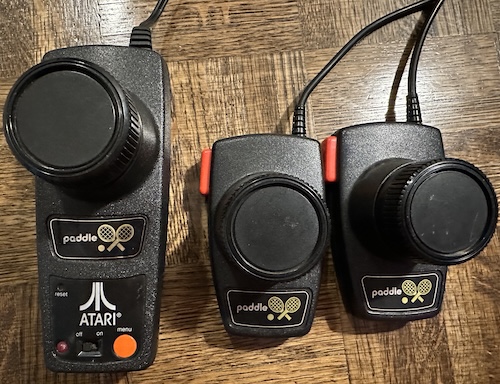
You might notice a big difference from the real Atari paddles, though. Not only are there a few more buttons and switches, but there’s only one! The Atari paddles actually came in pairs you plugged in both to the controller port; paddle games were very much multi-player focused. And yet, when Jakks put out the Atari Paddle, they had both one-player and two-player versions. And I got the one player.

While this is mostly fine, it has some interesting implications. For example, in Street Racer above, the left player mostly sits there getting into car crashes. For Pong, a game that they included in addition to Video Olympics, they had to implement a CPU player.
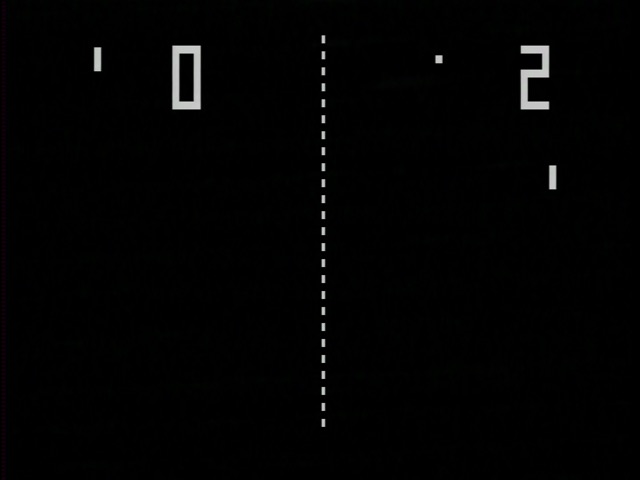
So it’s pretty clear that this thing is not running the original Atari 2600 games. Take a look at the other arcade game included, Warlords, and you’ll also realize that this isn’t running Atari 2600 hardware at all. There may be a lot of magic in modern 2600 homebrew, but the console just can’t put out pixels that small.

So, what is it?
In 2004, Atari put out the Atari Flashback 1, designed by Legacy Engineering. Well, they didn’t call it the Atari Flashback 1, just the Flashback. Surprisingly for something that looked like an Atari 7800, this machine was based on the ubiquitous NES-on-a-chip (“NOAC”) hardware. That’s right; if you can extract the ROMs, you can play their games on, say, a Twin Famicom. It’s particularly obvious in Yar’s Revenge, with its colorful neutral zone. Here’s a screenshot I took from the Atari 2600:
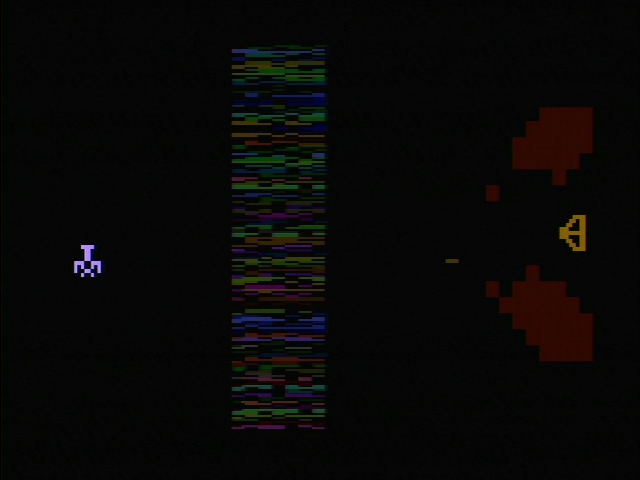
And here’s one from the NOAC port. Notice the NES can not display as many simultaneous colors on a single screen as the Atari 2600; the one advantage of this ancient technology, so the neutral zone is much less varied in color. (However, in motion, aggressive palette-cycling makes this less obvious)

So a lot of people have assumed that the Atari Paddle is also based on NOAC hardware. After all, the NES did have a paddle controller (used for Arkanoid), so that’s no obstacle. And Warlords in particular does really look like an NES game.
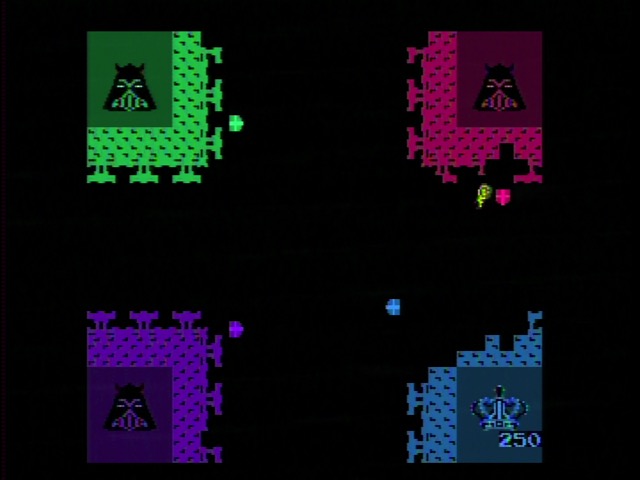
But it’s worth noting that this device was made by an entirely different team than the Flashback console; the Flashback was designed by Legacy Engineering, and the Atari Paddle by Digital Eclipse Vancouver.

But there’s one other thing that really blows the NOAC theory out of the water. The game select screen. Sorry, you’re just not getting that many colors or detail on Famiclone hardware.

Could it be one of the enhanced V.R. Technology NOACs? They did substantially expand the capabilities of the NES architecture. Well, you can actually read their datasheets today, and judging by the dates on them, they’re from mid-2005 at the earliest; it seems unlikely they’d be available in time for the Atari Paddle’s release a year earlier.
So, usually I’d go to MAME and just explain to you what someone there already figured out. But here’s a surprise: MAME doesn’t actually have the Atari Paddle! At least, I couldn’t find it. These things are reverse engineered by people, so it’s not surprising that they haven’t gotten 100% yet.
Should we crack it open?
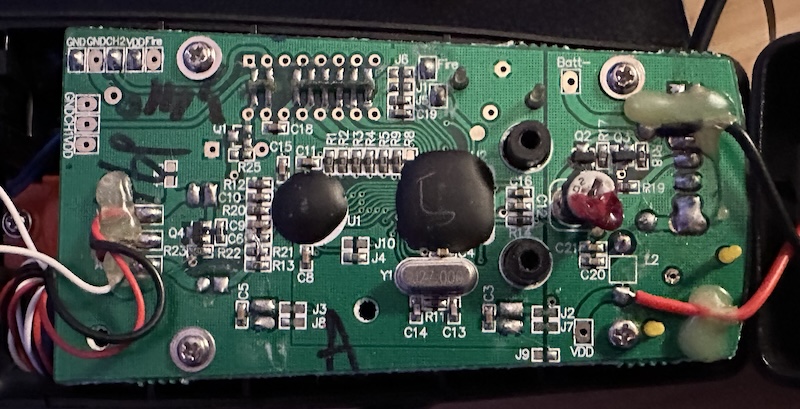
If you were expecting anything other than unlabeled epoxy blobs, I don’t know what to tell you. This is 2004. Interestingly, unlike some of the other plug and plays I’ve taken apart, this doesn’t seem to have any possibility of using a ROM chip either; I guess because of the small size of the PCB.
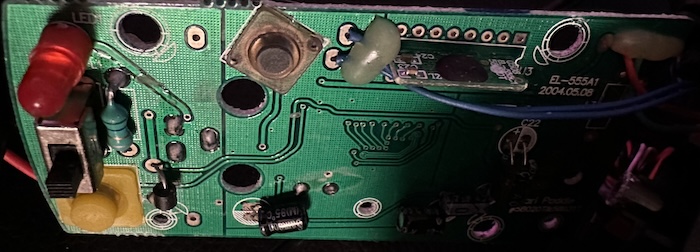
I didn’t really do a great job maneuvering the PCB to show the back, but the only interesting thing worth noting is the label EL-555A1 with a datecode of 2004.05.08, and that weird sticking-upward PCB in the spot for a DIP chip, labeled EL-555C1. I’m not sure what this is; an analog-to-digital converter for the paddle, perhaps? Though if you look at the pads on the other side, they seem to go to a missing transistor Q1 and the larger blob. It must do something. If you have the capability to decap these chips, then I may be up for sacrificing this little toy for the cause.
Internet archaeology
The AtariAge Forum, where the Atari experts hang out, has discussed the paddle before. They seem to like the paddle for the cheap toy it is, but the most interesting comment is from user onmode-ky.
FYI, the system was programmed by Jeff Vavasour’s team at Digital Eclipse Vancouver, using what was described as “partial emulation.” The underlying hardware seems to have been a Winbond W55x-family microcontroller, which is 65C816-compatible. Years later, after the closure of Digital Eclipse Vancouver, Vavasour’s current Code Mystics studio would develop the first Jakks Pacific plug-n-play game system running entirely via software emulation, their 2011 Taito (“Retro Arcade featuring Space Invaders”) system.
I’m not sure what “partial emulation” means. Perhaps some of the 6502 code from the original games was reused? (The 65C816 is backwards compatible) But the Atari 2600’s graphics system is so different from anything else that I have to assume only a small part of the logic could possibly be shared. Still, it sounds plausible enough.
Taking a look at MAME, I found one Winbond-made SoC that used a 65C816 CPU. The “trkfldch” core emulates a Winbond BAx-family chipset, used by Konami for the 2007 Track and Field TV Challenge plug-and-play game. I thought about getting one, but it’s one of those floor mat things and it sounded like exercise.
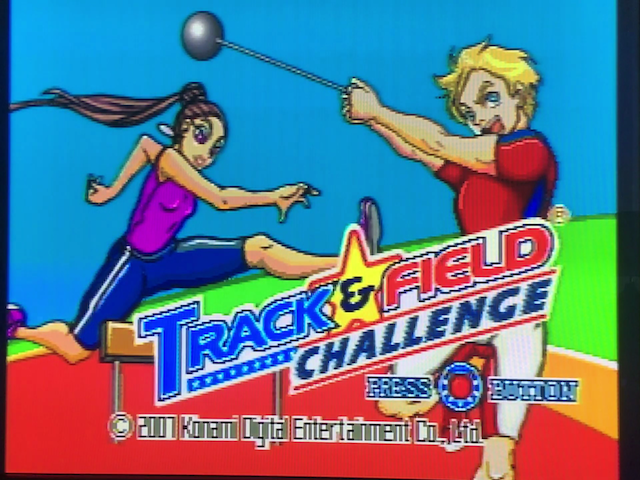
This is probably about as far as I’ll get in figuring out what’s running in this thing without decapping or other more invasive forms of research, unfortunately. Instead, let’s just play some more games.
The Lineup

These screenshots of the menu screen are really muddy, aren’t they? That just seems to be how it looks; my guess is the composite encoder here isn’t the highest-quality. As for the gameplay, certainly single-player games like Breakout, Super Breakout (different games), Circus Atari, Demons to Diamonds, or Night Driver play how you’d expect, as do Steeplechase and Warlords, which are just stuck in one-player mode.
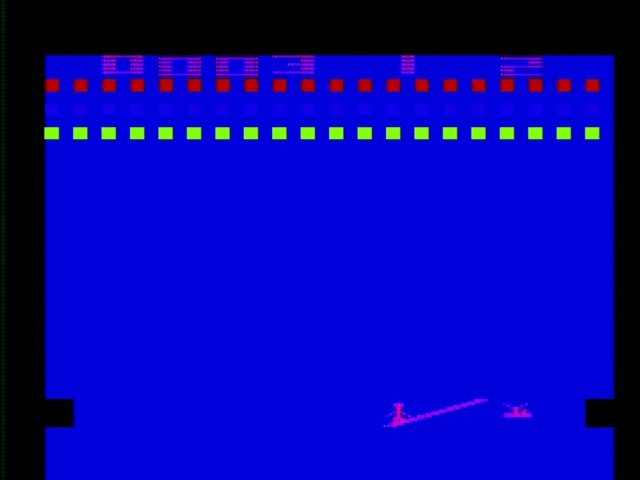
There’s definitely something odd going on with the rendering of multi-line effects, which are pretty much everywhere on this system. Look at the rendering of the defeated enemies in Demons to Diamonds, for example. These weird patterns seem to be everywhere; in the real game, they’re skull and crossbones. They’re inconsistent on a game-by-game basis, though– the Circus Atari score uses a similar effect and renders fine.
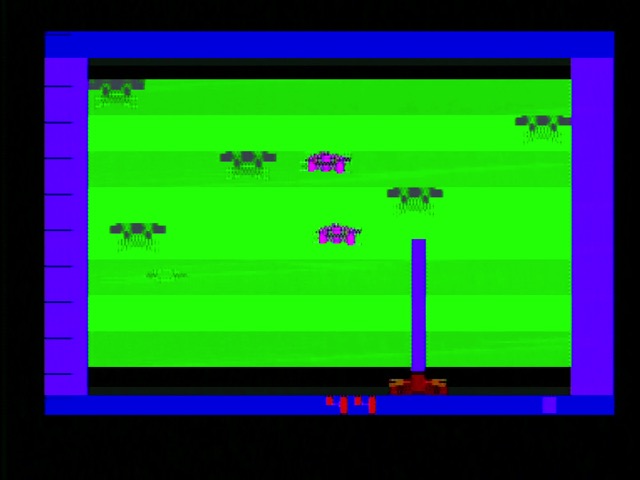
This is despite the fact that in other games, a high degree of accuracy is made. For example, did you know that Casino on the 2600 was a paddle game? Did you care? Notice those weird lines on the side; those happen when you call the HMOVE instruction that loads fine horizontal movement. They’re very common in 2600 games and many games don’t bother to hide them; you can see them in Demons to Diamonds above too.

Night Driver on the 2600 is a first-person racing game that makes its unique perspective by constantly flickering; I can’t show you a single screenshot because no single frame renders everything, but try pausing the video below. (Warning: it’s very flickery, and ends with a full-screen color flash. This could cause issues for those with photosensitivity) This effect is recreated faithfully, as are the HMOVE bars, which you can see during the color flash.
One thing you might have noticed about the Atari Paddle is that it seems to be missing a lot of controls. The Atari 2600 didn’t just rely on the button on the paddle; it used the many toggles and switches on the console itself to configure the game you’re playing. Well, most of those controls have been moved to software; pressing the large red “menu” button brings up a list of commands.
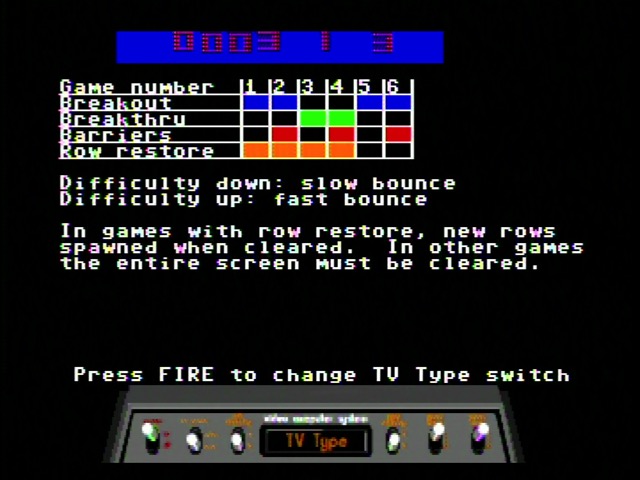
The two-player mandatory games are handled different ways. As noted, Street Racer above just gives you a second player who doesn’t do anything. Video Olympics (the 2600’s name for Pong) meanwhile seems to give you the same AI from the “arcade” version of Pong. Of course, you have a smaller play area, so that will impact difficulty.
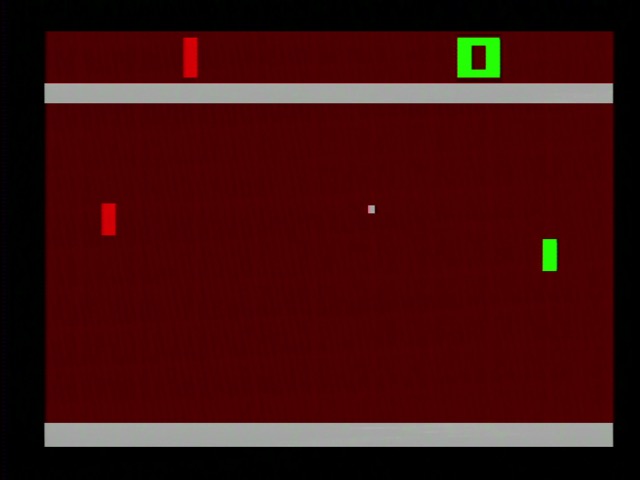
Must you play Atari today?
The Jakks Atari Paddle was released in 2004. Given that the 2600 was released in 1977, and this blog post is being written in 2025, this makes it more or less equivalent to a retro release of the Sega Dreamcast would be today. So that’s exciting.
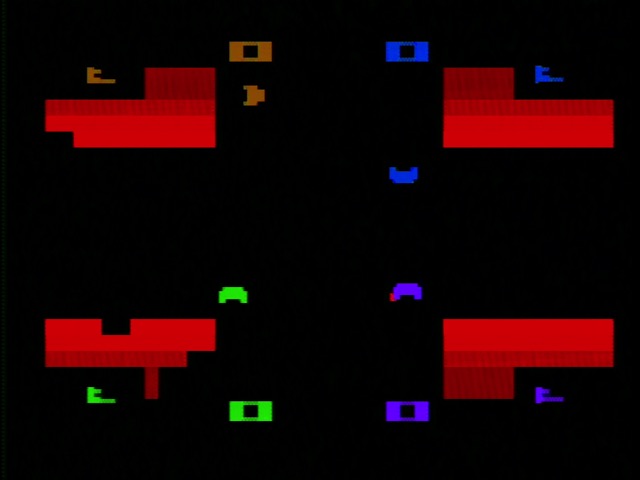
Overall I think the Atari Paddle is about where it should be. If you find one cheap in a bargain bin, it can be fun to play. I think the included 2600 version of Warlords is actually more fun than the included port of the arcade version, and if you’re absolutely desperate for single-player Video Olympics, this might be your only choice. But there’s no reason to go seeking it out. This, like all of Jakks Pacific’s contemporary releases, is nothing more than a fun novelty. That’s all it was meant to be.
UPDATE: Thank you to “The Dude” on Bluesky for pointing me to Jeff Vavasour’s own site here. I recommend reading it, lots of nice details on how they reverse engineered the 2600 titles and Jeff even notes that he himself drew the menu screen Atari 2600. Nice!
